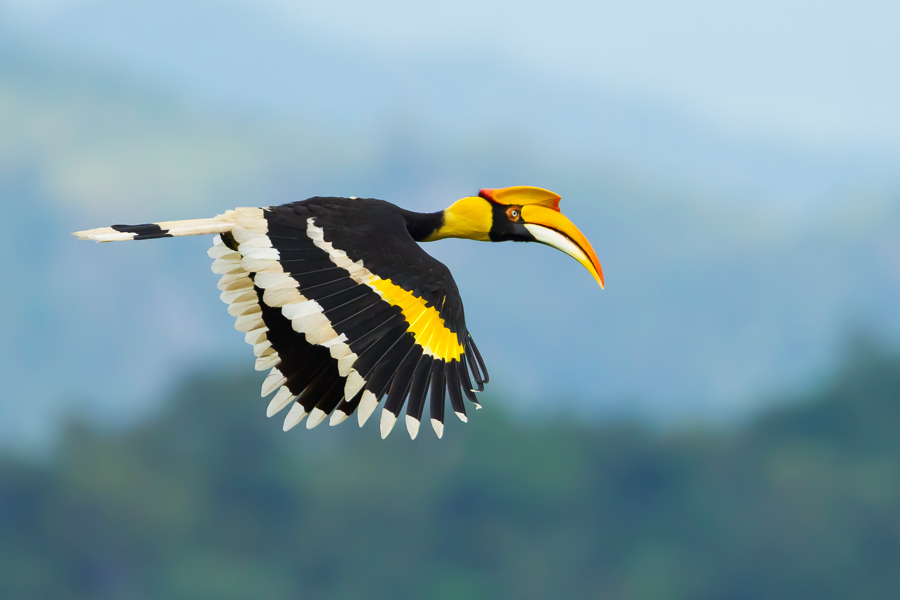[fshow photosetid=72157654834447466]
With some of the world’s most diverse ecosystems, plenty of sunshine and tropical climates, Southeast Asia is the perfect home to countless species of birds. Some of the most colourful winged creatures can be seen just outside your island bungalow or flying around the region’s metropolises.
As such, Southeast Asia is a birder’s paradise. Though you can incorporate bird watching into any journey or special tour, why not take time to explore some areas notable for their plentiful plumage and cheerful chirps?
Wings Near Wonders
Cambodia’s UNESCO World Heritage Site, Angkor Archaeological Park, simply must be seen to appreciate Khmer history. The collection of over 100 archaeological structures, including Angkor Wat, the world’s largest temple, draw streams of tourists from around the world.
Despite rapid development, the area near Siem Reap still has much dense forest growth covering it. This provides perfect cover for numerous bird species, so ‘twitchers’, the UK term for ‘birders’ or bird-watchers, are regularly treated to sightings in this area.
Take a guide like Sang Mony from the Sam Veasna Center, an environmental non-profit group, and you’ll likely spot many birds that might remain unseen on your own. A guide knows how to explore the region whilst avoiding packs of tourists that scare off birds.
Listen carefully and you’ll hear the Asian barred owlet’s soft hooting calls, or spy a lovely yellow-plumed black-naped oriole. I’m a long-time hawk fan from many USA hawk sightings and part-time docent work caring for birds of prey at the Arizona-Sonora Desert Museum, so it’s a bit of a joy eyeing a black baza in the wild; the striped underside and spiked crest make this species a fun one to watch as they dash branch to branch.
Special Sighting Trips
The Sam Veasna Center for wildlife conservation offers unparalleled private tours to Tmatboey in Cambodia’s northern plains not far from Angkor Wat. Nature experts have likened the area to Africa’s grand savannahs, from which we’ve probably all seen videos on Discovery Channel of throngs of birds in flight.
Many Asian avian populations have been decimated by illegal hunting and selling, over-building and destruction of natural grassland and jungle forest cover, and poisoning. Trammelling can also endanger entire bird populations.
Tmatboey has been carefully protected by agreements forged between the World Conservation Society (WCS), the Cambodian government and local villagers. Tourism is designed to control and restrict the number visitors while maximising chances of seeing two of the world’s rarest bird species: the white-shouldered ibis and its relative, the giant ibis.
Some other species of birds you can identify at Tmatboey include the white-rumped falcon, the greater and lesser adjutant stork, the greater spotted eagle, the Manchurian reed warbler, the sarus crane, the woolly-necked stork and a critically endangered white-rumped vulture, brought back to vitality by WCS staff after a near-death poisoning.
A Fowl Time in Thailand
Make your way to Phetchaburi’s Kaeng Krachan National Park, a beautiful area between Ratchaburi and Prachuap Kiri Khan, southeast of Bangkok, for great birding fun. You’re likely to get sightings of the extremely lovely blue-winged pitta if you delve into the denser coverage near Bang Krang camp.
Criss-crossing streams in these jungle forests make for gathering places for fowl, so perching nearby in some greenery may result in sightings. Look for the oddly beak-heavy rusty-cheeked hornbill, which can make a loud party if in a group. Long-tailed and silver-breasted broadbills and brightly front-plumed orange-breasted trogons can be found here, too. My favourite is the eye-catching but tiny Oriental dwarf kingfisher.
Vietnam Viewings
For a well-run avian exploration in Vietnam, consider Vietnam Birding, launched by Richard Craik in Ho Chi Minh City. They will coordinate tours that combine bird-watching with river cruises, wellness retreats or spa visits and round it all up with trips to unique cultural sites that guides explain in great detail.
Vietnam has a mix of environments that serve as homes to a variety of species. You can visit evergreen forests like Lang Bian mountain to photograph and hear calls of a wide range of cuckoo, woodpecker, hornbill and babbler.
Climbing higher into semi-evergreen forested areas like those at southern Cat Tien National Park you may see many types of flycatchers, thrushes and nuthatches. If you’re lucky, you’ll get a rare glimpse of a grey-crowned crocia or the seldom seen collared laughing thrush. Other southern Vietnam habitats include the many grasslands and mudflats of the Mekong Delta and the montane evergreen forests on the Dalat Plateau.
The north’s Red River Delta has beautiful Xuan Thuy National Park, limestone carsts aplenty at Cuc Phuong National Park, and plenty of evergreen and borderline alpine bird ‘hangouts’ at both Ba Vi and Tam Dao National Parks. Central region bird-watching locations include the UNESCO Natural World Heritage Site of Phong Nha-Ke Bang National Park in Quang Binh province. It’s a bit difficult to get to but worthwhile for sightings of the sooty babbler and limestone leaf-warbler. In nearby Bach Ma National Park you can see dozens of species of birds such as the northern brown hornbills, the silver pheasant, the crested arguse and rare Indochinese wren-babbler.
TreeTop Tips for Birders
Only a few countries are mentioned here, but all of the Southeast Asian countries provide splendid opportunities for bird watching. Several islands are home to rare endemic fowl and offer select tours through their varied climates to sight rare seabirds and jungle creatures. The same holds true of mountainous regions full of awe-inspiring raptors. This list only touches on a fraction of a long list. Look to Borneo, China and Myanmar for more.
Unique Tmatboey eco-tourist guesthouses offer comfortable stays for visiting birder-watchers. Specially conservationist-trained locals escort guests on area tours. Sometimes, a US$30 donation is given to the guide by each twitcher spotting a white-shouldered ibis.
For tours worldwide that include every climate from Antarctic to steamy jungle, consult these and other tour providers:
- Birdquest: www.birdquest-tours.com
- Birdtour Asia: www.birdtourasia.com
- VENT Tours: www.ventbird.com/birding-tours/asia

